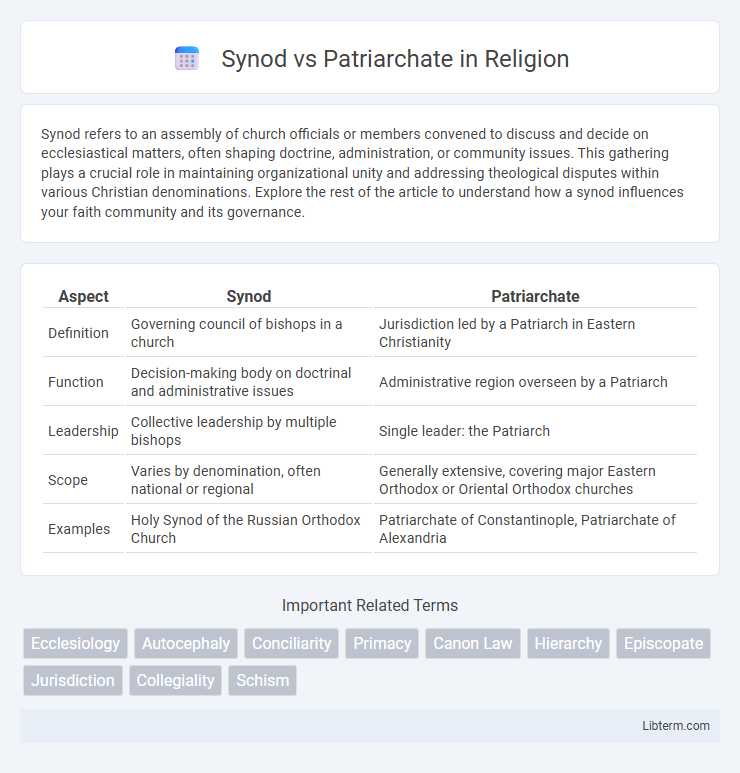Synod refers to an assembly of church officials or members convened to discuss and decide on ecclesiastical matters, often shaping doctrine, administration, or community issues. This gathering plays a crucial role in maintaining organizational unity and addressing theological disputes within various Christian denominations. Explore the rest of the article to understand how a synod influences your faith community and its governance.
Table of Comparison
| Aspect | Synod | Patriarchate |
|---|---|---|
| Definition | Governing council of bishops in a church | Jurisdiction led by a Patriarch in Eastern Christianity |
| Function | Decision-making body on doctrinal and administrative issues | Administrative region overseen by a Patriarch |
| Leadership | Collective leadership by multiple bishops | Single leader: the Patriarch |
| Scope | Varies by denomination, often national or regional | Generally extensive, covering major Eastern Orthodox or Oriental Orthodox churches |
| Examples | Holy Synod of the Russian Orthodox Church | Patriarchate of Constantinople, Patriarchate of Alexandria |
Understanding Synod and Patriarchate: Key Definitions
A Synod is a council or assembly of clergy and sometimes laity in a church, primarily responsible for governing, doctrinal decisions, and ecclesiastical administration. A Patriarchate refers to the jurisdiction or office of a patriarch, who is a senior bishop in certain Christian traditions, often overseeing a large and historically significant church region. Understanding the distinctions between a Synod as a collective decision-making body and a Patriarchate as an ecclesiastical territory or leadership office is crucial for grasping church governance structures.
Historical Origins of Synods and Patriarchates
Synods originated in early Christianity as assemblies of bishops convened to deliberate on doctrinal, disciplinary, and administrative matters, reflecting the communal decision-making process of the early Church. Patriarchates emerged later as hierarchical centers of ecclesiastical authority, with the five major patriarchates--Rome, Constantinople, Alexandria, Antioch, and Jerusalem--established by the 4th century, each led by a patriarch overseeing regional churches. The historical distinction between synods and patriarchates illustrates the development from collective episcopal councils to centralized leadership structures within Christian ecclesiology.
Organizational Structure: Synod vs Patriarchate
The organizational structure of a Synod consists of a council of bishops or church leaders who collectively govern and make decisions on ecclesiastical matters, reflecting a more democratic and consultative approach. In contrast, a Patriarchate is centered around a Patriarch, who holds a higher hierarchical authority and leads the church with centralized power, often symbolizing unity and continuity within an autocephalous or autonomous church. The Synod functions as a deliberative body, while the Patriarchate emphasizes top-down leadership and spiritual oversight.
Roles and Functions in Church Governance
The Synod serves as a collective governing body responsible for making doctrinal decisions, disciplinary actions, and administrative oversight in the church, embodying a council of bishops or clergy. The Patriarchate, led by the Patriarch, provides spiritual leadership, represents the church in external affairs, and ensures unity and continuity of tradition within the ecclesiastical jurisdiction. Both entities work collaboratively, with the Synod emphasizing collegial governance and the Patriarchate focusing on hierarchical authority and symbolic representation.
Decision-Making Processes Compared
Synods consist of councils of bishops or church leaders who collectively discuss and vote on doctrinal, liturgical, and administrative matters, emphasizing a more collaborative decision-making process. In contrast, patriarchates centralize authority in the office of the Patriarch, who often has the final say in significant decisions, reflecting a hierarchical and top-down governance structure. This difference highlights how synods promote shared leadership, while patriarchates emphasize singular ecclesiastical authority within Eastern Orthodox, Oriental Orthodox, and some Eastern Catholic churches.
Influence and Authority within Christian Traditions
Synods function as governing councils in Christian traditions, exercising collective decision-making authority over doctrinal, liturgical, and administrative matters. Patriarchates, as hierarchical institutions led by Patriarchs, hold supreme spiritual and administrative authority within particular autocephalous or autonomous churches, especially in Eastern Orthodoxy and Oriental Orthodoxy. The balance of influence varies, with Patriarchates often embodying centralized leadership, while Synods represent a more collegial governance model shaping church policies and teachings.
Synod and Patriarchate in Eastern Orthodoxy
The Synod in Eastern Orthodoxy is a governing council composed of bishops that collectively makes decisions on doctrinal, liturgical, and administrative matters within a particular autocephalous church. The Patriarchate refers to the jurisdiction and authority of a Patriarch, who serves as the highest-ranking bishop and spiritual leader in certain autocephalous Orthodox Churches, such as the Ecumenical Patriarchate of Constantinople. Synods operate under the leadership of the Patriarch, ensuring unity and consistency in church governance and theology across the Eastern Orthodox communion.
Synod and Patriarchate in Roman Catholicism
The Synod in Roman Catholicism refers to an assembly of bishops convened to discuss and decide on important ecclesiastical matters, serving as an advisory body to the Pope. The Patriarchate, specifically the Latin Patriarchate of Jerusalem and other Eastern Catholic Patriarchates, represents a major episcopal jurisdiction overseen by a Patriarch with authority over a particular rite or region within the Church. Both institutions play distinct roles in governance, with the Synod focusing on collective decision-making, while the Patriarchate asserts hierarchical leadership within its traditional territory.
Challenges and Controversies: Synod vs Patriarchate
The Synod and Patriarchate often face challenges related to authority and decision-making, as synods represent collective episcopal governance while patriarchates emphasize centralized leadership under a single patriarch. Controversies arise from differing interpretations of canonical laws, jurisdictional disputes, and the balance between tradition and modern ecclesiastical needs. These tensions frequently impact church unity, liturgical practices, and the political influence of religious institutions in regions such as Eastern Orthodox and Oriental Orthodox communities.
Modern Relevance and Future Perspectives
Synods function as collective governing bodies within churches, facilitating collaborative decision-making and ensuring doctrinal unity, while patriarchates represent the hierarchical leadership centralized under a patriarchy in Orthodox Christianity. Modern relevance lies in synods' adaptability to contemporary ecclesiastical challenges through inclusive dialogue, whereas patriarchates maintain historical continuity and authoritative guidance. Future perspectives indicate increasing dialogue between synods and patriarchates to balance tradition with evolving administrative needs in global religious communities.
Synod Infographic

 libterm.com
libterm.com